

Employee Wellness Programs: Are they worth the money? [Infographic] Employee Wellness Programs: Are they worth the money?
![Employee Wellness Programs: Are they worth the money? [Infographic]](http://cdn.pearltrees.com/s/pic/th/employee-wellness-infographic-124078386)
[infographic] Take the video tour Click infographic for full view Share this Image On Your Site <p><strong>Please include attribution to with this graphic. Related Resources. Poor Employee Health Habits Drive Lost Productivity. Poor Employee Health Habits Drive Lost Productivity Aug. 8, 2012 — Unhealthy individual lifestyle choices may result in substantially higher levels of lost productive work time, according to findings form a study published in the October issue of Population Health Management.
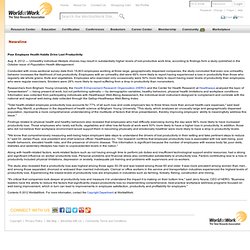
Conducted with cross-sectional survey data from 19,803 employees working at three large, geographically dispersed companies, the study concluded that even one unhealthy behavior increases the likelihood of lost productivity. Employees with an unhealthy diet were 66% more likely to report having experienced a loss in productivity than those who regularly ate whole grains, fruits and vegetables. Bending health cost curve tied to wellness communication.
Study: Wellness programs have bigger payoff than previously reported - Related Stories - SmartBrief on Workforce. Are Workplace Wellness Programs an Effective Investment? LEAN Works: Why: Return on Investment. Return on investment (ROI) analysis is a form of cost-benefit analysis that measures the cost of an intervention compared to the expected financial return of the intervention.7, 8 Obesity is linked to many co-morbid conditions resulting in increased health care costs.
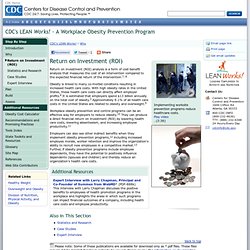
With high obesity rates in the United States, these health care costs can directly affect employer profits.4 It is estimated that employers spend $13 billion annually on the total cost of obesity.3 Approximately 9.1% of all health care costs in the United States are related to obesity and overweight.9 Workplace obesity prevention and control programs can be an effective way for employers to reduce obesity.10 They can produce a direct financial return on investment (ROI) by lowering health care costs, lowering absenteeism, and increasing employee productivity.11 Please note: Some of these publications are available for download only as *.pdf files. These files require Adobe Acrobat Reader in order to be viewed. National Employee Wellness Month. The State of Corporate Wellness Programs. The SHRM Workplace Forecast: It’s Health, Health, and More Health. SHRM released its biennial report on workplace trends (the SHRM Workplace Forecast) this month.

It’s really about health. Health is the workplace trend to be thinking about and working on. Its tentacles reach out and grasp all other workplace trends. Top Workplace trends for 2011 Continuing high cost of employee health care coverage in the United States.Passage of federal health care legislation.Increased global competition for jobs, markets and talent.Growing complexity of legal compliance for employers.Changes in employee rights due to legislation and/or court rulings.Large numbers of Baby Boomers (1945–1964) leaving the workforce at around the same time.Economic growth of emerging markets such as India, China and Brazil.Greater need for cross-cultural understanding/savvy in business settings.Growing national budget deficit.Greater economic uncertainty and market volatility.
All but three of the top workforce trends relate, in some fashion, to health. Top social and demographic trends. Wellness Programs Produce Stronger, More Productive Workers. Wellness Programs Produce Stronger, More Productive Workers Jan. 20, 2012 — Americans work harder, are more productive and miss fewer days of work as a result of wellness benefits programs, according to the latest Principal Financial Well-Being Index. 41% of workers agree that having a wellness program encourages them to work harder and perform better at work.
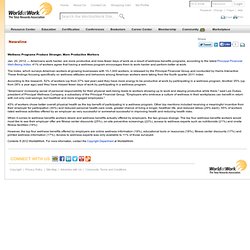
The index, which surveys American workers at growing businesses with 10-1,000 workers, is released by the Principal Financial Group and conducted by Harris Interactive. These findings focusing specifically on wellness attitudes and behaviors among American workers were taking from the fourth quarter 2011 index. Measuring Tangible and Intangible Success of Your Corporate Health and Wellness Program by From the HRIQ Editorial Desk. Businesses make commitment to improving employee health.
A raft of leading employers have signed up to a government-backed campaign to encourage workers to lead healthier lifestyles.
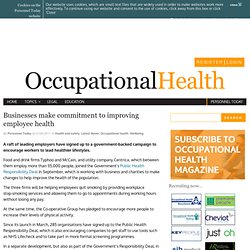
Food and drink firms Typhoo and McCain, and utility company Centrica, which between them employ more than 35,000 people, joined the Government’s Public Health Responsibility Deal in September, which is working with business and charities to make changes to help improve the health of the population. The three firms will be helping employees quit smoking by providing workplace stop-smoking services and allowing them to go to appointments during working hours without losing any pay. At the same time, the Co-operative Group has pledged to encourage more people to increase their levels of physical activity. Since its launch in March, 285 organisations have signed up to the Public Health Responsibility Deal, which is also encouraging companies to get staff to use tools such as NHS Lifecheck and to take part in more formal screening programmes. Worksite Wellness Shows Solid Return on Investment. A new report shows that the number of companies with 20,000 or more employees that provided fitness centers, subsidies or other fitness oriented wellness programs grew by 11 percent from 2009, according to a 2010 national survey by Mercer (a benefits consulting firm) reports the Washington Post.

Another survey, by the Society for Human Resource Management, shows that the proportion of companies offering gym benefits has held steady since 2007. During the same period, many employers were cutting back on retirement and other financial benefits because of the recession. The reason, according to many studies, is that wellness benefits provided in the workplace yield more productive employees who require less health care. Cost cutting and consumer-driven healthcare put employees in charge of their wellbeing benefits, says Mercer. David Woods , 31 Jan 2012.

Well Workplace - Cost Benefits. Today, more than 81% of America’s businesses with 50 or more employees have some form of health promotion program the most popular being exercise, stop-smoking classes, back care programs, and stress management.
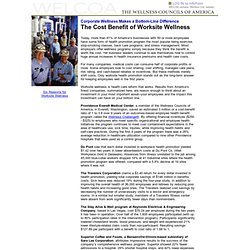
Most employers offer wellness programs simply because they think the benefit is worth the cost. Yet business leaders continue to ask themselves how to control huge annual increases in health insurance premiums and health care costs. For many companies, medical costs can consume half of corporate profits or more. Some employers look to cost sharing, cost shifting, managed care plans, risk rating, and cash-based rebates or incentives. But these methods merely shift costs. Worksite wellness is health care reform that works. Du Pont saw that each dollar invested in workplace health promotion yielded $1.42 over two years in lower absenteeism costs at Du Pont Co. Do wellness efforts aid retention? — free-range communication.